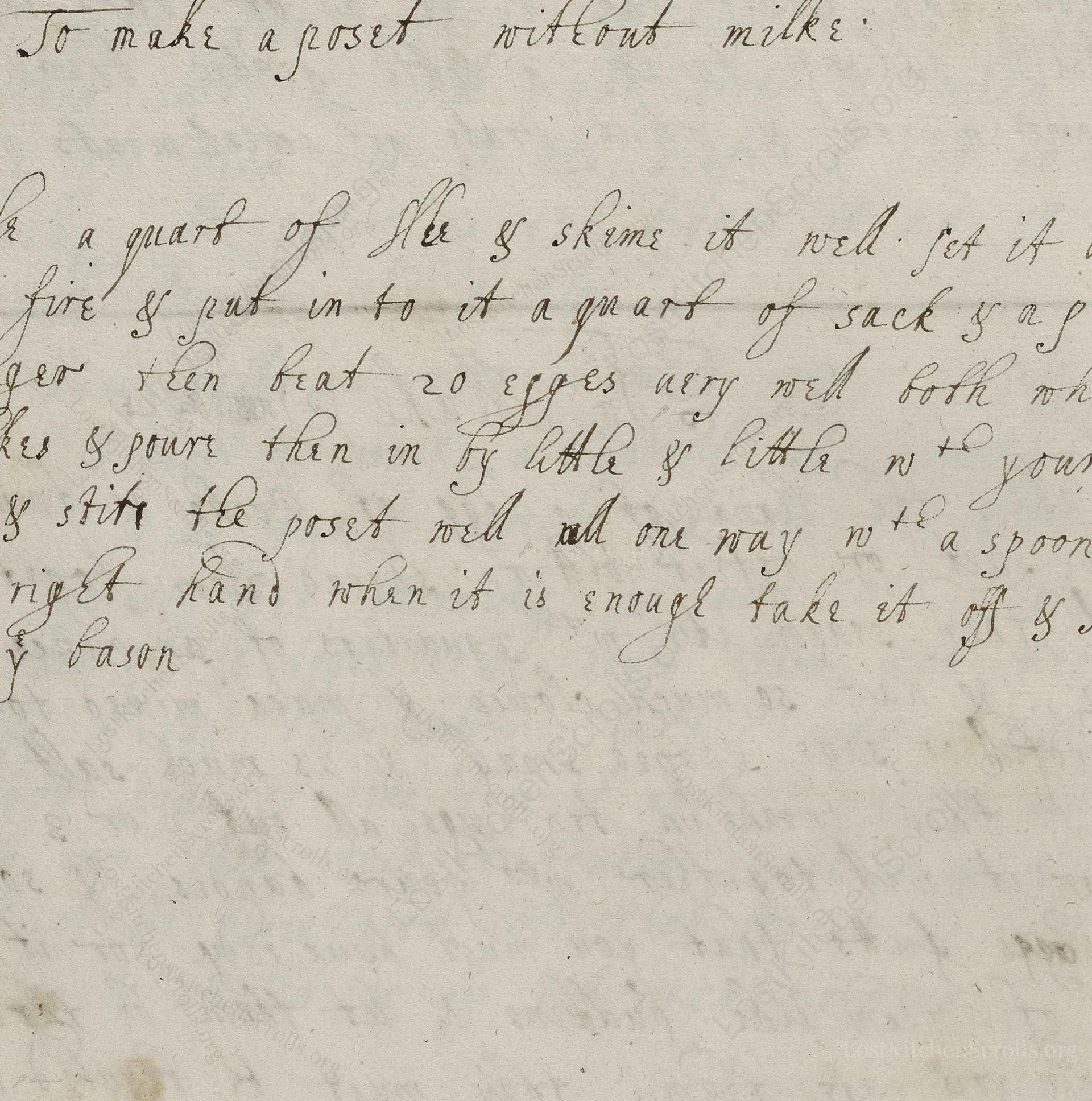To Make A Posset Without Milke
From the treasured pages of Receipt book of Rebeckah Winche
Written by Rebecca Winch

To Make A Posset Without Milke
"Boyle a quart of the skime it well. set it on a gentle fire & put in to it a quart of sack & a pound of suger then beat 20 egges very well both whites & yolkes & poure then in by little & little wth your left hand, & stirr the posset well all one way wth a spoon in your right hand when it is enouge take it off & put it in a bason"
Note on the Original Text
Seventeenth-century recipe writers often assumed the reader had substantial kitchen knowledge, so instructions were brief, prioritizing method over exactness. Terms like 'quarte', 'sack', and 'suger' uses historical spellings and refer to volumes and items familiar to contemporary cooks. The instruction to stir 'all one way' reflects period beliefs about consistent textures. The spelling and order are true to Rebecca Winch’s original handwriting, which features variable orthography and assumes a well-trained domestic staff for execution.

Title
Receipt book of Rebeckah Winche (1666)
You can also click the book image above to peruse the original tome
Writer
Rebecca Winch
Era
1666
Publisher
Unknown
Background
Step into the 17th-century kitchen with Rebecca Winch, where hearty feasts and time-honored recipes whisper secrets of early English cooking. From savory pies to delicate sweets, this charming volume offers a sumptuous glimpse into culinary history.
Kindly made available by
Folger Shakespeare Library
This recipe hails from the late 17th century, around 1666, written by Rebecca Winch, a woman of status during the Restoration period in England. Possets were popular warming drinks made by curdling or thickening wine or ale with milk or eggs, often sweetened and spiced. This particular posset, made without milk, was likely intended as a comforting, nourishing beverage, possessing both restorative and festive qualities. During this time, sack was a favored drink among the English elite, and such possets were enjoyed at social gatherings and sometimes used for medicinal purposes.

The original cook would have used a cauldron or heavy pot suspended over a hearth or set over embers for gentle, controlled heating. Beating eggs would be done with a wooden whisk or spoon in a large bowl. The mixture would be stirred with a sturdy wooden spoon, always in one direction. The finished posset would be poured into a ceramic or pewter basin for serving. Measuring was approximate, relying on experience, but the 'quart' measure was standard in most kitchens.
Prep Time
15 mins
Cook Time
15 mins
Servings
8
We've done our best to adapt this historical recipe for modern kitchens, but some details may still need refinement. We warmly welcome feedback from fellow cooks and culinary historians — your insights support the entire community!
Ingredients
- 1 quart filtered water
- 1 quart dry sherry or medium-dry fortified wine (substitute for sack)
- 1 pound (2 cups) granulated sugar
- 20 large eggs
Instructions
- Begin by skimming impurities from 1 quart of water, or use filtered water to approximate what 'skimm'd' water meant.
- Gently heat the water in a pot over low heat.
- Add 1 quart of dry sherry (to stand in for 'sack', a fortified wine popular in the 17th century) and 1 pound of sugar (2 cups).
- Separately, beat together 20 large eggs (both yolks and whites) until well blended.
- Gradually pour the beaten eggs into the warm wine mixture in a slow stream, using your left hand, while continuously stirring in one direction with a wooden spoon in your right hand.
- Continue stirring gently, making sure not to scramble the eggs, until the mixture thickens slightly but does not boil.
- Once suitably thickened, remove from heat and transfer to a serving bowl.
- Serve warm.
Estimated Calories
325 per serving
Cooking Estimates
Preparing this recipe takes about 15 minutes, including skimming or filtering the water, measuring the ingredients, and beating the eggs. Cooking takes about 15 minutes, since you slowly heat the mixture without letting it boil and stir until it thickens. The recipe makes 8 servings. Each serving is about 325 calories, mainly from the eggs, sugar, and wine.
As noted above, we have made our best effort to translate and adapt this historical recipe for modern kitchens, taking into account ingredients nowadays, cooking techniques, measurements, and so on. However, historical recipes often contain assumptions that require interpretation.
We'd love for anyone to help improve these adaptations. Community contributions are highly welcome. If you have suggestions, corrections, or cooking tips based on your experience with this recipe, please share them below.
Join the Discussion
Rate This Recipe
Dietary Preference
Main Ingredients
Culinary Technique
Occasions

Den Bockfisch In Einer Fleisch Suppen Zu Kochen
This recipe hails from a German manuscript cookbook compiled in 1696, a time whe...

Die Grieß Nudlen Zumachen
This recipe comes from a rather mysterious manuscript cookbook, penned anonymous...

Ein Boudain
This recipe comes from an anonymous German-language manuscript cookbook from 169...

Ein Gesaltzen Citroni
This recipe, dating from 1696, comes from an extensive anonymous German cookbook...
Browse our complete collection of time-honored recipes



